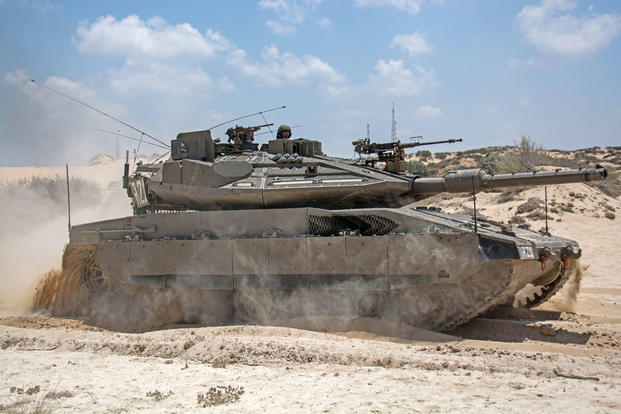ABERDEEN, Maryland -- The Israelis call it the "Windbreaker" that already is protecting their Merkava 4 tanks against rocket-propelled grenades and anti-tank missiles, and now the U.S. Army is close to giving the go-ahead to install it on the M1A1 Abrams main battle tanks.
The Windbreaker, more commonly called the "Trophy Active Protection System," was designed to detect incoming projectiles and neutralize them with ball-bearing filled canisters fired off like buckshot.
"We're very close to a decision on the Trophy system," Army Maj. Gen. David Bassett, the Army's program executive officer for ground combat systems, said last week.
"We're looking to make those decisions rapidly so that we can spend money in the next Fiscal Year," he said. He ultimately envisioned "a brigade's worth of capability of Trophy on the Abrams."
The Trophy Active Protection System, developed by Israel's Rafael Advanced Defense Systems and Israel Aircraft Industries' Elta Group, began being installed on Merkava main battle tanks in 2009. The Israeli Defense Forces claim that the system has worked effectively in Israeli engagements against Hamas in the Gaza Strip.
The system relies on fire-control radars and four mounted antennas giving 360-degree coverage. When incoming is detected, internal computers instantly calculate firing angles and activate two rotating launchers on the sides of the vehicle that fire off a shotgun-like blast. The estimated cost of Trophy per tank is $350,000-$500,000.
Two other active protection systems are also being considered by the Army -- Iron Curtain, developed by the Artis technology firm of Herndon, Va., and Iron First, designed by Israel Military Industries.
The installment of an active protection system on the Abrams would be a first for the Army, which has been looking for a system to protect armor since the Korean War.
According to the U.S. Army Tank-Automotive Research, Development, and Engineering Center (TARDEC), "Active Protection Systems have been in the design and development stages since the early 1950s, but none has successfully made the transition from development to integration on a platform."
Bassett spoke last Tuesday at the Aberdeen Proving Grounds in Maryland, where the new 30mm cannon for the Stryker vehicle infantry squad transporter was going through test firings before being deployed next year with the 2nd Cavalry Regiment based in Vilseck, Germany.
Bassett and Col. Glenn Dean, Project Manager Stryker Brigade Combat Team, said the 30mm cannon and the Raytheon Common Remote Operations Weapon Station II, or CROWS II, which will enable a gunner to aim and fire the FGM-148 Javelin anti-tank missile while buttoned up inside the vehicle, were prime examples of their approach to upgrading entire families of vehicles in the Army's Armored Brigade Combat Team inventory.
With the exception of BAE Systems Armored Multi-Purpose Vehicle (AMPV), which will replace the venerable tracked M113 Armored Personnel Carrier, the Army was going with upgraded and remodeled versions of existing platforms rather than more costly new designs, Bassett and Dean said.
"One of the things that makes acquisition go faster is by picking things that don't require as much design," Bassett said. "I'm not interested in developing, I'm interested in delivering."
Bassett said he was working off an annual budget of about $3 billion and that money was "stretched over a vast portfolio. We take that amount of resources and get the most out of it we possibly can."
"Despite the fact that we have not been given the resources to start new programs for the replacement of some of our main combat systems, we used those resources effectively and that put us in a position to upgrade the entire ABCT (Armored Brigade Combat Team) formation, roughly at the same time," Bassett said.
With that approach, Bassett said his teams were working on an upgrade of the M1A1 Abrams tank -- the 73-ton M1A2 SEP V3; an upgraded Bradley troop carrier, the M2A4; and an upgraded Paladin howitzer, the M109A7.
-- Richard Sisk can be reached at Richard.Sisk@Military.com.










